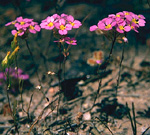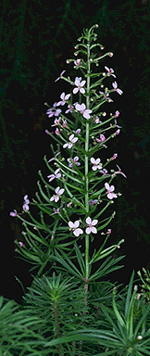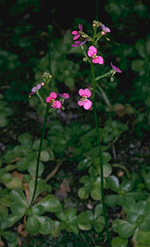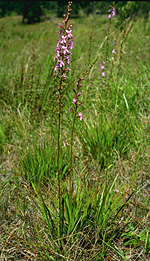 |
This family is predominantly Australian (with a few species in Malesia, New Zealand and Chile). Its centre of diversity is in the south-west of Western Australia, but with some species found almost anywhere on the mainland and in Tasmania, usually in open heathlands on seasonally moist, sandy soils.
Characteristic features of the family Stylidiaceae in Australia include: - annual or perennial herbs, sometimes tiny, sometimes sub-shrubby, with leaves in basal rosettes or whorls
- flowers small but often showy, pink, red, purple, yellow or white, zygomorphic with a tubular, often glandular-hairy calyx and tubular corolla with spreading lobes
- petals 5, but usually only 4 of them prominent
- stamens 2, fused with the style to form a usually irritable column that snaps onto the flower when triggered by the pollinator
- ovary inferior, developing into a capsule enclosed in the persistent calyx
Description
Evergreen shrubs, or annual or perennial terrestrial herbs.
Perennating by rhizomes or crowns. Vegetative reproduction absent, or
by rhizomes. Internal secretions not obvious. Plants glabrous, or with
simple, glandular or non-glandular, unicellular hairs. Leaves alternate
and spiral or apparently whorled, or if herbs then the leaves cauline,
all or mostly basal, or both basal and cauline, sessile or rarely subsessile.
Stipules absent. Lamina simple, symmetric, filiform, acicular, subulate,
linear, lanceolate, ovate, elliptic, oblanceolate, oblong, spathulate
or orbicular; base cuneate, attenuate or rounded; margins entire or dentate
±flat, revolute or recurved; one-veined, or the venation pinnate,
or parallel, with the midrib conspicuous or inconspicuous, and the tertiary
venation not reticulate; surfaces not punctate; herbaceous or leathery.
All the flowers bisexual. Inflorescences terminal, consisting of spikes,
racemes, panicles, corymbs or solitary flowers. Bracts present. Bracteoles
present or apparently absent. Pollination by insects. Flowers sessile
or stalked. Floral disc absent; nectaries present on the disc. Free hypanthium
present. Perianth of 2 dissimilar whorls, imbricate in bud. Calyx irregular;
segments fused, with 5 lobes; calyx cup-shaped, urn-shaped, funnel-shaped
or tubular, herbaceous. Corolla irregular or rarely regular; segments
fused, with 4–5 lobes, alternating with the calyx lobes; corolla salver-shaped
or tubular, 1-lipped, white, cream, pink, magenta or purple, without contrasting
markings, or streaked, spotted, etc, membranous; lobes ±entire,
or notched, emarginate, bifid, bilobed, trifid, trilobed or more divided.
Fertile stamens 2, not clearly correlated with the calyx lobes. Staminal
filaments fused to the style forming a column, or apparently absent. Anthers
basifixed, not versatile, opening outwards by longitudinal slits, 2-celled.
Ovary inferior. Carpels 2, fused; ovary with 1–2 locules. Style present
and the stigma variable. Stylar column frequently irritable, bent to the
labellar side and snapping to opposite side when touched. Ovules numerous
per locule, sessile; placentation axile or free-central. Fruit a dry,
dehiscent septicidal capsule; the perianth on the maturing fruit deciduous,
dry and persistent, or growing larger. Disseminule macro-surface featureless,
winged or costate; micro-surface ±smooth, orange or brown, dull.
Seeds numerous per fruit. Aril absent. Cotyledons 2. Embryo round or shapeless.
(Note: this description has been generated from the coded data compiled for the key. Any errors in the key data will be reflected in the descriptions.)
A treatment of the family Stylidiaceae has not yet been published in the Flora of Australia. It will appear in Volume 34.
Australian genera of Stylidiaceae (as recognised for the Flora of Australia)
Forstera
Levenhookia
Phyllachne
Stylidium

|
  |

Levenhookia leptantha (flowering plants)
Photo: A.S.George © A.S.George

Stylidium adnatum (flowers)
Photo: M.Fagg © ANBG

Stylidium debile (flowers)
Photo: M.Fagg © ANBG

Stylidium graminifolium (flowering plant)
Photo: G.Leiper © G.Leiper

|
 |
|